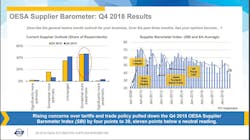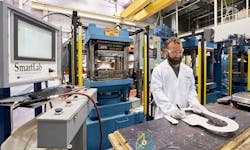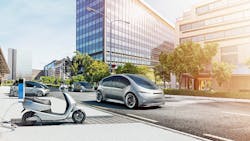Rough Roads: Will Political Uncertainty Slow Automotive Innovation?
For Joe Hinrichs, Ford’s president of the Americas, Fourth of July week 2018 was a fireworks show that needed no pyrotechnics. Tariffs on automobiles shipped to China from the U.S. went from 25% on June 30, down to 15% on July 1, then all the way up to 40% on July 7. U.S. President Donald Trump and Chinese President Xi Jinping were exchanging threats and issuing ultimatums in an escalating trade war.
Boats bound for China in June idled in international waters, so they could drop anchor when the lower tariffs went into effect on July 1. Meanwhile, other, more distant boats gunned to arrive at port on July 6, before the 40% tariffs took hold.
“We tried like heck to get them in there in those six days,” Hinrichs recalled during a speech at a U.S./Canada automotive supplier luncheon in September. “That gives you a feeling for how crazy things are right now.”
On any ordinary day in history, manufacturing a car has more variables than manufacturing most other things. The post-Great Recession years have brought additional variables: The accelerating pace of technology. Consumers not wanting what technology can deliver, on technology’s schedule. Electrification. Connectivity. Autonomy. Mobility. A skilled workforce that may or may not have the expertise technology requires.
And then along comes populist discontent, and you’ve got a bubbling stew of uncertainty ready to boil over: The looming Brexit. President Trump and his Twitter finger. A renegotiated, yet-to-be ratified NAFTA/USMCA. Tariffs that send supply-chain experts and their analytics software spinning.
During his speech to suppliers, Hinrichs called the “totality and complexity” of trade conversations “unlike anything I’ve ever seen.” In the long-ago days of the pre-Trump presidency, U.S. administrations would negotiate a trade agreement with one nation at a time, he noted. But that pace seems quaint now.
With “the added complexities” of the Section 232 tariffs on imports to the U.S. of aluminum and steel, in the name of national security, “you have EU conversations, Mexico conversations, China and other-country conversations,” said Hinrichs.
Ping-ponging can be exhilarating—and, ultimately, exhausting. Just in the first five days of December 2018, breaking news affecting the auto industry included:
• President Trump threatening to tear up the existing NAFTA agreement after Congress raised doubts about his update to it, the U.S.-Mexico-Canada Agreement (USMCA).
• A Trump and Xi meeting at the G-20 summit, where they declared a 90-day rest period on tariffs.
• Trump declaring himself a “Tariff Man” and casting doubt on the 90-day truce by sending conflicting messages about what he and Xi actually agreed on in the meeting.
• A White House announcement that it was officially eliminating all subsidies for electric cars.
• GM President and CEO Mary Barra meeting with Trump and U.S. lawmakers to defend GM plant closings announced on November 26.
There are signs that all the uncertainty is taking a toll, that innovation in the U.S. automotive industry is beginning to suffer. Automotive leaders stretched thin have started to make hard choices on costs and dial back on initiatives.
China Rising
If 2018 doesn’t qualify as a rough year for the automotive industry, it’s at least shaping up to be a transitional one. At the beginning of 2018, fresh off the tax cut, supplier optimism on the OESA’s Supplier Barometer Index was at 57, above the 50-point threshold for an overall optimistic 12-month outlook.
By Quarter 3 of 2018, the optimism score had dropped to 43. [In the weeks since, it has crept down to 39]. “That certainly reflects significant concern,” says Mike Jackson, OESA’s executive director, strategy and research.
The biggest source of concern? Trade. “We asked, ‘What are the top threats to your outlook?’ and number one was ‘Changing trade policy,’” says Jackson.
Topping the list of specific trade worries: The uncertainty surrounding the details of the new NAFTA/USMCA trade agreement between the U.S., Mexico and Canada. Automakers need to know the fine print to make investment decisions, and they’ve already seen raw material costs rising dramatically for both steel and aluminum, says Jackson. (Ford CEO Jim Hackett says his company would take a $1 billion hit in profits from the tariffs between 2018 and 2019.)
Some OESA members have experienced a 20%-plus increase on steel pricing, both domestic and foreign. The rising costs are “not just a couple of isolated incidents, but it’s actually pretty widespread,” says Jackson. “And so that represents a significantly higher cost in a rising interest rate environment,” adding up to “a tremendous headwind for the supply base.”
Additional costs without an increase in revenue mean cuts. OESA figures—the latest of which were compiled coming off a big tax cut at the end of the first quarter of 2018—show a slight decline in R&D spending from suppliers in the upper revenue quartile: from 6% of total sales spent on R&D in 2017 to a projected 5% of total sales in 2018.
Whether that decline is a blip or a signal of bigger R&D cutbacks to come, it’s too early to say.
“I think what’s going to be really challenging is to continue innovating as we’ve seen, along with being a bit more mindful of costs from the standpoint that the economic environment has softened,” says Jackson.
Carla Bailo, president and CEO of the Center for Automotive Research and a former senior vice president of research and development at Nissan, says that at the moment, automakers are looking for ways to make cuts without cutting innovation.
“So far, we haven’t seen anybody back off on thinking about the future, because that’s almost a death sentence in today’s world,” she says. “But you have seen some of the expense or cost reductions starting, the reluctance to invest in new buildings—like GM had a lot of renovations planned, they cut those—and reducing head count. I think they’re looking at ways to begin to hedge the potential impacts, or in some cases the real impacts, from steel and aluminum [tariffs], for example.”
Fuel Follies
What may already be dealing a blow to U.S. innovation is the Trump administration’s proposed freezing of Corporate Average Fuel Economy (CAFE) Standards for passenger vehicles. The proposal, which is on the fast track for approval, would reduce the fuel economy requirements for new cars—which were to top out at 54 mpg in 2025—by 15+ mpg.
This sudden shift in U.S. standards also shifts the focus of high-demand innovation—and the engineers behind them—away from the U.S. “Electrification is going to go to China probably; already they have over 300 EV startups in the country and tons of research on battery technology, " Bailo says. "And Europe as well—they’re going to be ahead of us. So it’s discouraging from that point. Because we’re not home-growing the talent anymore. Professors and doctoral students will go where they get funding—and if it’s not important for our country, funding’s not going to come from the National Science Foundation or the normal sources.” Just recently, she noted, two University of Michigan professors left their posts to work in research for Didi, the Uber of China.
Andy Beer is vice president of Composites North America at Ashland*, a $900 million company that develops resins used with carbon glass or carbon fiber in the lightweighting of vehicles. Beer sees the company’s automotive business showing the most growth in China, and has noticed that China’s lightweighting innovation has begun to eclipse lightweighting innovation in the U.S.
“We started seeing it on the composite side maybe three years ago,” Beer says. “And it’s accelerating. The Chinese pretty much started with this very basic stamp-and-seal, using relatively basic, older technology, and now with their shift, their move to EVs, we’re seeing a rapid increase in technology in China.”
Supplier Strategy
Mary Gustanski, Delphi’s chief technology officer, says that the rollback of U.S. fuel economy standards is a detour, not a roadblock, for Delphi’s electrification strategy. China, with higher emissions standards similar to Europe’s taking shape, has already surpassed the U.S. as the largest automobile market in the world, and the thinking is that the U.S. will eventually follow the rest of the world to electrification.
“While we’ve seen the U.S. look like it’s going to take perhaps a relaxation, a delay in achieving some of the tighter standards, Europe and China are not backing down,” Gustanski says. “If anything, they’re talking about getting more aggressive.”
Even in the U.S., electrification solutions will become increasingly prevalent because of the heightened power requirements of complex connected and automated systems “that drive you to at least hybrid systems,” she says.
But although commercial vehicle shows in places like Hannover and Aachen are all about electrification, that doesn’t mean the end of the internal combustion engine. Delphi is agnostic in its power strategy, says Gustanski, with the focus on delivering power in smaller, lighter packages that also reduce cost and the complexity of the manufacturing process. Their power electronics strategy is all in the packing: eliminating bulky orange cable connectors, engineering new configurations.
“OEMs are so busy electrifying vehicles that they’re not spending a lot of resources redesigning engines,” says Gustanski.
Delphi is not competing in electric motors or batteries because OEMs want to own the electronic motor technology themselves, and electric battery market is already owned by big players like Samsung and LG, says Gustanski.
Having an interdisciplinary team working together is key to keeping everyone nimble and on the cutting edge of research and development in uncertain times, says Stefan Koidl, who leads Bosch’s powertrain passenger car systems and electric drive engineering in North America.
Last year, Bosch combined all engine development, including both gas-powered and electric, into a single division—a move that integrated 88,000 employees globally. Both technologies, working in tandem, power hybrid engines that are on the rise in Europe because of the demise of light diesel, “so it made sense,” says Koidl. “We’re thinking across the powertrain, which is different than in the past. If you’re talking hybrid, if we want to optimize our systems and your expertise is in the combustion engine, you need to have a good understanding of what’s changing around electrification, and the other way around.”
Although the technology is ready, consumer acceptance is happening more slowly and the combustion engine will still play a major role. Bosch estimates that 15% of all new vehicles globally will be hybrids or electric cars by 2025, and 30% by 2030. In the U.S., the rate for electrification is just 1%, but awareness of electric vehicles is growing. Koidl sees the challenge in the U.S. as not so much to keep increasing the charging range of EVs and hybrids (higher charging requires heavier and more costly batteries, increasing the cost of the car) but increasing charging availability and convincing U.S. consumers that charging is not as onerous as it’s cracked up to be.
“We will not depend on really large batteries for these vehicles,” he says.
Rough Draft of the Future
Autonomous driving technology is another area where consumer acceptance and government regulations are significantly behind technology development. While self-driving cars have no shortage of buzz—and projecting what could be is a fun exercise—research and development in autonomy has not commensurately grown. Instead, it remains a relatively small part of companies’ research budgets. In 2017, autonomy was the lowest priority for automotive suppliers’ R&D technology investments, according to the OESA’s Supplier Barometer Index.
Randy Miller, global and transportation sector leader for EY professional services firm, says that with product development cycles at leading-edge auto companies running two to three years, and autonomous implementation five to 10 years out, autonomy may not seem real enough yet to merit more research investment.
“One of the biggest hurdles is consumer adoption—how comfortable consumers are in actually, fully embracing autonomous drive vehicles. I think the technology is in a good position—it’s really there, almost today," Miller says. "The rest of the infrastructure needs some continued evolution to be able to support it.”
Miller expects continued focus on EVs despite changes in U.S. regulatory standards. The bigger risk for cuts as tariff costs rise and car sales soften—with the give and take between new technology and investing in plant improvements and new plants—would be some of the mobility-as-service ventures.
“We’re still seeing support, but I think we’re starting to approach a bit of a tipping point, in that many of these models aren’t necessarily making money yet," he says. "If we don’t start seeing some positive return on those investments, you’re at risk that those could get cut.”
CAR’s Bailo says that OEMs' mobility-as-a-service models like GM’s Maven and Ford’s Chariot lack direction and excitement; they need to learn from startups like May Mobility and SPLT “showing and demonstrating what they’re doing that’s cool,” for instance, going to universities and demoing their products.
They also need a higher purpose. “Some of the demos they’re doing in various municipalities need to actually do some public good,” she says. “For example, there’s lots of startups that are doing things that are related to healthcare, getting people who need to get to appointments there, persons with disabilities. Not delivering pizzas in a car but doing something that really changes people’s lives and allows them to get to work or to healthcare to improve their lives.”
With all the variables, leading an automotive company is the most challenging it’s ever been. “I think it requires somebody who’s good at multitasking and thinking multi-dimensionally and making sure you’ve got the right team that can cover any deficiencies you have in your way of thinking,” says Bailo.
Bailo points to GM’s Mary Barra as a leader who has assembled a particularly solid team that can think strategically and comprehensively,. Toyota has similar leadership and “the money to do whatever they want; they’re the richest auto manufacturers."
Ford CEO Jim Hackett is also a visionary, Bailo says, but at this point his strategy is still a bit undefined.
"I think the disruption that’s happening today is nebulous in many ways," she says. "There are so many different ways you can go as a company; you need to figure out where you’re going to place your bets because you can’t play in every sphere.”
One thing is certain: Automotive leaders will have to make some serious strategic moves to remain profitable and position themselves as relevant and forward-thinking through economic and technological change, political decisions and the fickle winds of consumer preference.
They have to think big and broadly about where to invest their resources at a time when belts are tightening but a missed partnership with a tech startup or another automotive company could render them irrevelant. They have to balance vision with risk: Consolidating or moving operations, streamlining platforms and laying off workers in order to reposition themselves for an electrified future might be the straight path to profitability. And then they have to figure into the calculus how much they can push before a world leader pushes back or worse, they turn off consumers.
If they can do all that, plus cultivate a solid corporate culture, prevent cybersecurity breaches, slow climate change and stay out of Japanese prisons, they’re good.
*The story initially referred to Ashland as Composites North America.
About the Author

Laura Putre
Senior Editor, IndustryWeek
As senior editor, Laura Putre works with IndustryWeek's editorial contributors and reports on leadership and the automotive industry as they relate to manufacturing. She joined IndustryWeek in 2015 as a staff writer covering workforce issues.
Prior to IndustryWeek, Laura reported on the healthcare industry and covered local news. She was the editor of the Chicago Journal and a staff writer for Cleveland Scene. Her national bylines include The Guardian, Slate, Pacific-Standard and The Root.
Laura was a National Press Foundation fellow in 2022.
Got a story idea? Reach out to Laura at [email protected]




